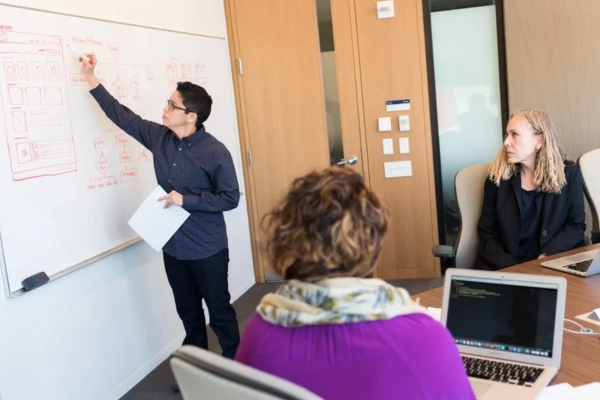While trying to navigate the rapid evolving technological advancements, the conventional methods of IT management are undergoing a profound transformation. Strategies that once served businesses adequately may now fall short in meeting the demands of today’s business landscape. Fractional IT Teams exemplify a fundamental shift in the approach to addressing IT needs within companies, offering a dynamic and scalable solution tailored to the requirements of contemporary enterprises. As organizations strive for heightened agility, innovation, and cost-efficiency, Fractional IT Teams have emerged as a strategic asset, driving the agenda of digital transformation, and optimizing IT functionality. At their core, Fractional IT Teams comprise seasoned professionals who seamlessly integrate into organizations, tackling diverse and evolving technological needs with precision.
For Chief Technology Officers, entrusted with the monumental task of steering IT projects while adjusting to budget constraints and resource limitations, the emergence of Fractional IT Teams presents an alluring proposition. Gone are the days of solely relying on in-house talent or committing to full-time hires; instead, CTOs can now tap into the expansive pool of expertise offered by Fractional IT Teams on an as-needed basis. This strategic maneuver not only shields organizations from the pitfalls of talent scarcity and skill gaps but also empowers them to adapt swiftly to the dynamic currents of the moment.
Fractional IT Teams act as agile allies in the CTO’s arsenal, swooping in to boost project teams with specialized skills and knowledge precisely tailored to the task at hand. Picture a squadron of tech experts, each wielding a unique set of tools, ready to lend their talents to propel projects forward. This collaborative approach amplifies the project’s capabilities and injects a fresh perspective into the team, fostering innovation.

Understanding Fractional IT Teams
To truly grasp the essence of Fractional IT Teams, let’s take a closer look at how they operate and what they bring to the table. Unlike conventional staffing models that rely on maintaining a fixed roster of full-time employees, Fractional IT Teams operate on a dynamic and project-centric basis. Comprising seasoned professionals with diverse skill sets, these teams are meticulously assembled to address the specific needs of each client. By hand-picking the right mix of talents, Fractional IT Teams empower organizations to tackle intricate IT initiatives with ease.
The modus operandi of Fractional IT Teams revolves around flexibility and scalability. Need extra firepower during a busy period? They’ve got you covered. Got a specialized project that needs some expert hands on deck? Consider it done. And the best part? You get all this without the hefty costs that come with traditional hiring. Plus, the strategic advantage of Fractional IT Teams lies in their adaptability, allowing organizations to swiftly reallocate resources in response to unforeseen opportunities. It’s like having a secret weapon for staying ahead of the curve.
Benefits for CTOs
Among the advantages that a CTO will encounter when working with a Fractional IT team, flexibility stands out as a primary asset. Whether embarking on software development endeavors, executing cloud migration strategies, or fortifying cybersecurity protocols, CTOs can tap into Fractional IT Teams to access specialized talent.
In addition, Fractional IT Teams present a cost-effective solution for optimizing resource allocation and maximizing return on investment. By engaging Fractional IT Teams on a project-by-project basis, organizations sidestep fixed overhead expenses, like training expenditures, salaries, and benefits. This streamlined staffing approach reduces operational outlays while empowering CTOs to allocate resources strategically, directing financial resources towards initiatives that promise significant business growth and competitive advantage.
Relationship Dynamics
Within the Fractional IT Team, the existing relationships among members are deeply rooted in trust, teamwork, and confidence in each other’s abilities. Unlike ad-hoc teams that come together for specific projects, the members of a Fractional IT Team have likely collaborated for an extended period, forging strong bonds along the way. This familiarity with one another’s working styles, strengths, and areas for growth fosters a sense of cohesion and camaraderie that is invaluable in achieving project objectives.
The trust that characterizes the relationships within a Fractional IT Team is built upon a foundation of shared experiences and successful collaborations. Members have weathered challenges, celebrated victories, and navigated setbacks together, strengthening their bonds with each other. This mutual trust enables seamless communication and collaboration, as team members feel secure in expressing their ideas, concerns, and feedback openly.
The teamwork within a Fractional IT Team is characterized by a high level of coordination and synergy. Each member understands their role and responsibilities within the team, allowing for efficient task delegation and execution. There is a collective commitment to the success of the project, with team members leveraging their complementary skills and expertise to achieve common objectives.
Given the transient nature of Fractional IT teams, members must proactively seek to understand and accommodate each other’s needs. Grasping each other’s needs extends beyond interpersonal connections to encompass a comprehensive understanding of project requirements and organizational goals. By aligning their actions with the main strategic objectives of the organization, members can ensure that their contributions are also strategically significant.
And perhaps one of the most interesting things of the relationships within a Fractional IT Team is the deep respect for each other’s abilities and contributions. Members value each other’s expertise and perspectives, recognizing the unique strengths that each individual brings to the team. This respect fuels collaboration and creativity, as team members feel empowered to share ideas and explore innovative solutions.

Efficiency in Collaboration
Working together in Fractional IT Teams comes with some advantages when it comes to getting things done quickly and effectively. By bringing together a diverse array of specialists with complementary skills and expertise, organizations tap into a wealth of collective intelligence and problem-solving capabilities. This collaborative synergy drives innovation and facilitates the achievement of project objectives. Fractional IT Teams are all about working smart. They adopt agile methodologies and iterative development approaches to streamline processes, mitigate bottlenecks, and expedite time-to-market for IT initiatives.
Clear communication and transparent project management practices are pivotal drivers of efficiency. Regular meetings, progress updates, and the utilization of collaborative tools facilitate real-time information exchange and decision-making. This ensures team members remain aligned and responsive. And it’s not just about getting the job done; it’s about getting better at it too. Fostering a culture of continuous improvement and knowledge sharing empowers team members to leverage best practices and deliver superior outcomes.
Composition of Fractional IT Teams
By now you know that Fractional IT Teams are known for their adaptability and versatility. While the composition of these teams may vary depending on the project’s nature and scope, there are several core roles that are commonly present across different engagements. These roles encompass a wide spectrum of expertise, reflecting the multifaceted nature of modern IT projects.
Software engineers are pivotal in the design, implementation, and development of software solutions that align with both functional and technical requirements. IT architects take charge of designing the overarching system architecture and infrastructure, ensuring scalability, reliability, and security. When it comes to Web development, Front-End developers appear as vital contributors, captivating user interfaces using HTML, CSS, and JavaScript to ensure seamless user experiences. At the same time, Back-End developers are working behind the curtain to power the site’s functionality with languages like Python, Java, and PHP.
Collaboration Strategies
Effective collaboration among Fractional IT Teams, CTOs, and MSPs relies on clear communication, shared objectives, and a collaborative approach. To cultivate a culture of alignment, transparency, trust, and mutual respect must be prioritized.
One of the best ways to encourage collaboration is by laying out clear roles, responsibilities, and expectations for everyone involved. By clarifying boundaries and establishing accountability mechanisms, organizations can minimize conflicts and inefficiencies stemming from overlapping roles. Additionally, organizations should encourage cross-functional collaboration to leverage diverse perspectives and expertise.
Teams should be encouraged to experiment, iterate, and innovate to achieve better outcomes. Embracing a growth mindset and viewing both successes and failures as learning opportunities creates a better environment. There, teams will feel empowered to challenge the status quo and push the boundaries of what’s possible.
Choosing the Right Fractional IT Team
Selecting the ideal Fractional IT Team for a project requires a thoughtful approach, considering various factors. To establish a successful partnership, organizations must conduct thorough evaluations of potential Fractional IT Teams, assessing their expertise, experience, and track record in delivering similar projects.
The first step in selecting the right Fractional IT Team involves defining clear project objectives, scope, and deliverables. By clearly articulating project requirements upfront and communicating them effectively to prospective teams, organizations can ensure alignment and minimize potential misunderstandings later on. Then, it’s time to evaluate the technical skills, domain knowledge, and industry experience of the potential Fractional IT Team to ensure they are capable of executing the project successfully.
In addition to technical proficiency, organizations should also evaluate the cultural fit and collaborative dynamics. This involves assessing compatibility with the organization’s values, communication style, and working culture. Furthermore, organizations should investigate the track record and reputation of potential Fractional IT Teams by seeking client testimonials, case studies, and references to validate their capabilities.
Ultimately, selecting the appropriate Fractional IT Team is about conducting thorough due diligence and ensuring they possess the requisite skills and experience, and collaborative spirit to help you hit it out of the park with your project. Fortunately, with companies like Coding IT, making this selection becomes a much simpler task. Our team is committed to delivering enduring solutions, no project is too big or too small for us. Fill our form and let’s have a meeting to determine the steps to take for your company’s growth.
